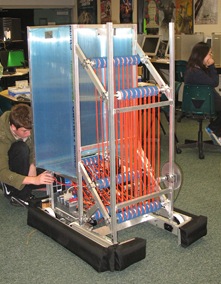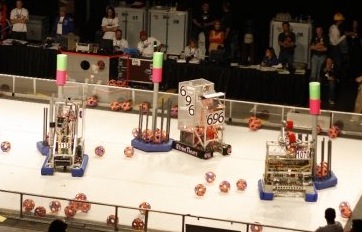String Theory — 2009

Testing String Theory on the night before ship
String Theory was our robot for the 2009 game, Lunacy. It was designed as an offensive 'bot, holding up to 30 balls ("moonrocks") at a time and able to deliver those balls into a trailer with great speed. It was able to pick up moonrocks from the floor or receive them from human players, and deliver them into the goal quickly. It also handled "empty cells," scooping them up from the floor and shooting them into the "fueling stations."
One of the unique things about String Theory was its traction control system. Lunacy was played on an extremely low-friction surface, making good traction control essential to game play. Instead of using complicated programming involving tracking a "follower wheel" to control our traction, we decided on a programming-controlled mechanical solution to the design challenge. In low traction situations, the driver would pull a trigger which would make the wheels accelerate slowly from stop to full power. The robot would gain traction over an extended period, and be able to move forward more quickly.

String Theory in action at the Los Angeles Regional
Technical Specifications:
Weight: 118.1 lbs
Height: 60 inches
Drive Train
– Two CIM motors
– AndyMark kit transmissions with custom housing
– Long and narrow configuration
– Six wheeled tank drive
Conveyor System
– Three conveyor belt system for easy ball handling
– CIM motor and GEM500 gearbox driving pickup conveyor at 1400 RPM
– Two globe motors driving conveyors at 320 and 240 RPM
– Hopper that holds up to 30 balls
– Custom-machined aluminum sprockets for motor reduction
Electrical
– Fold-down electronics panel for easy access
Programming
– One-joystick or two-joystick driving modes
– Trigger-activated traction control
– Sophisticated camera software for tracking trailers and autonomous scoring
